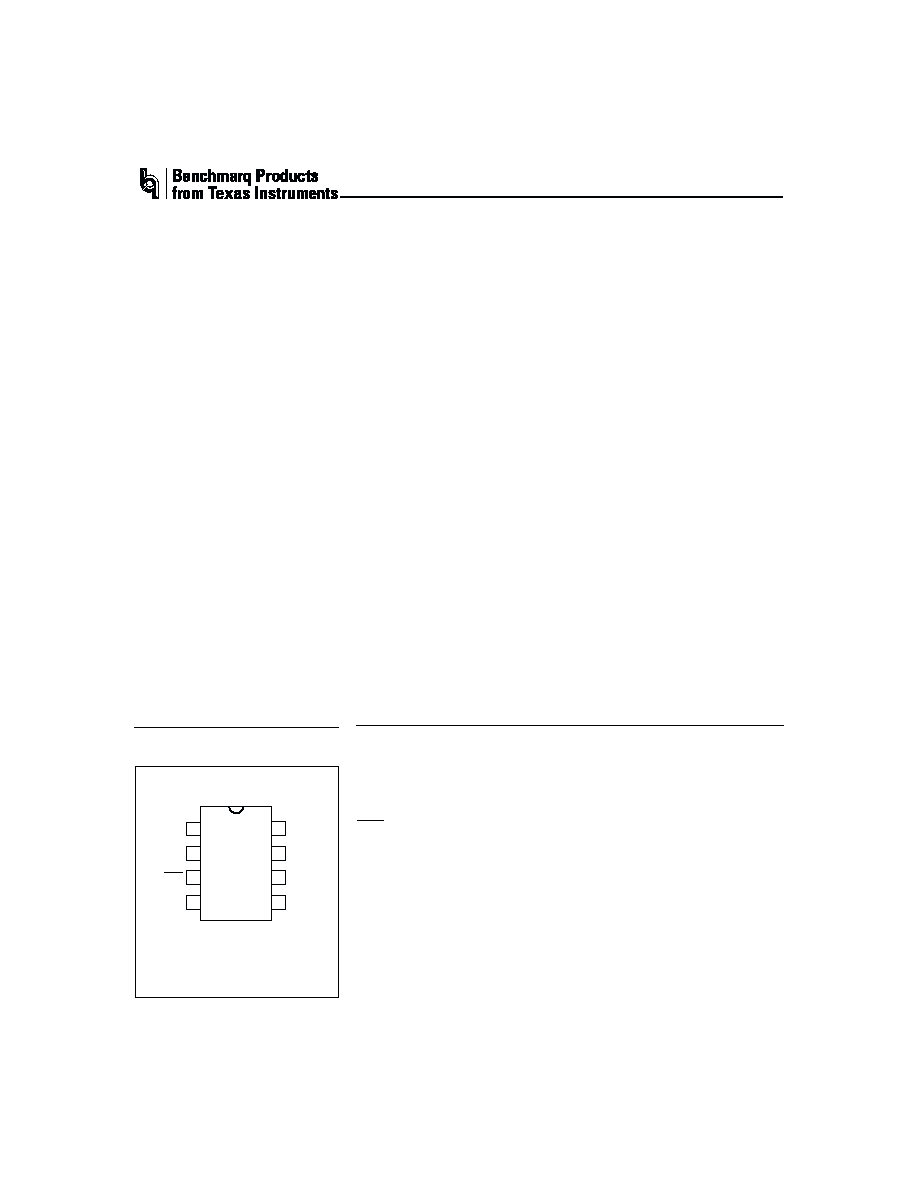
1
Features
S a f e m a n a g e m e n t o f f a s t
charge for NiCd, NiMH, or Li-
Ion battery packs
High-frequency switching con-
troller for efficient and simple
charger design
Pre-charge qualification for
detecting shorted, damaged, or
overheated cells
Fast-charge termination by
peak voltage (PVD), minimum
current (Li-Ion), maximum
temperature, and maximum
charge time
Selectable top-off mode for
achieving maximum capacity in
NiMH batteries
Programmable trickle-charge
mode for reviving deeply dis-
charged batteries and for post-
charge maintenance
Built-in battery removal and
insertion detection
S l e e p m o d e f o r l o w p o w e r
consumption
General Description
The bq2000 is a programmable,
monolithic IC for fast-charge manage-
ment of nickel cadmium (NiCd),
nickel metal-hydride (NiMH), or lith-
ium-ion (Li-Ion) batteries in single- or
multi-chemistry applications. The
bq2000 detects the battery chemistry
and proceeds with the optimal charg-
ing and termination algorithms. This
process eliminates undesirable under-
charged or overcharged conditions
and allows accurate and safe termi-
nation of fast charge.
Depending on the chemistry, the
bq2000 provides a number of charge
termination criteria:
n
Peak voltage, PVD (for NiCd and
NiMH)
n
Minimum charging current (f or
Li-Ion)
n
Maximum temperature
n
Maximum charge time
For safety, the bq2000 inhibits fast
charge until the battery voltage and
temperature are within user-defined
limits. If the battery voltage is
below the low-voltage threshold, the
b q 2 0 0 0 u s e s t r i c k l e - c h a r g e t o
condition the battery.
For NiMH
batteries, the bq2000 provides an
optional top-off charge to maximize
the battery capacity.
The integrated high-frequency com-
parator allows the bq2000 to be the
basis for a complete, high-efficiency
power-conversion circuit for both
nickel-based and lithium-based
chemistries.
bq2000
SNS
Current-sense input
V
SS
System ground
LED
Charge-status
output
BAT
Battery-voltage
input
1
PN-2000.eps
8-Pin DIP or Narrow SOIC
or
TS
SOP
2
3
4
8
7
6
5
SNS
LED
BAT
VSS
MOD
VCC
TS
RC
Pin Connections
Pin Names
Programmable Multi-Chemistry
Fast-Charge Management IC
SLUS138B�FEBRUARY 2001 F
TS
Temperature-sense
input
RC
Timer-program input
V
CC
Supply-voltage input
MOD
Modulation-control
output
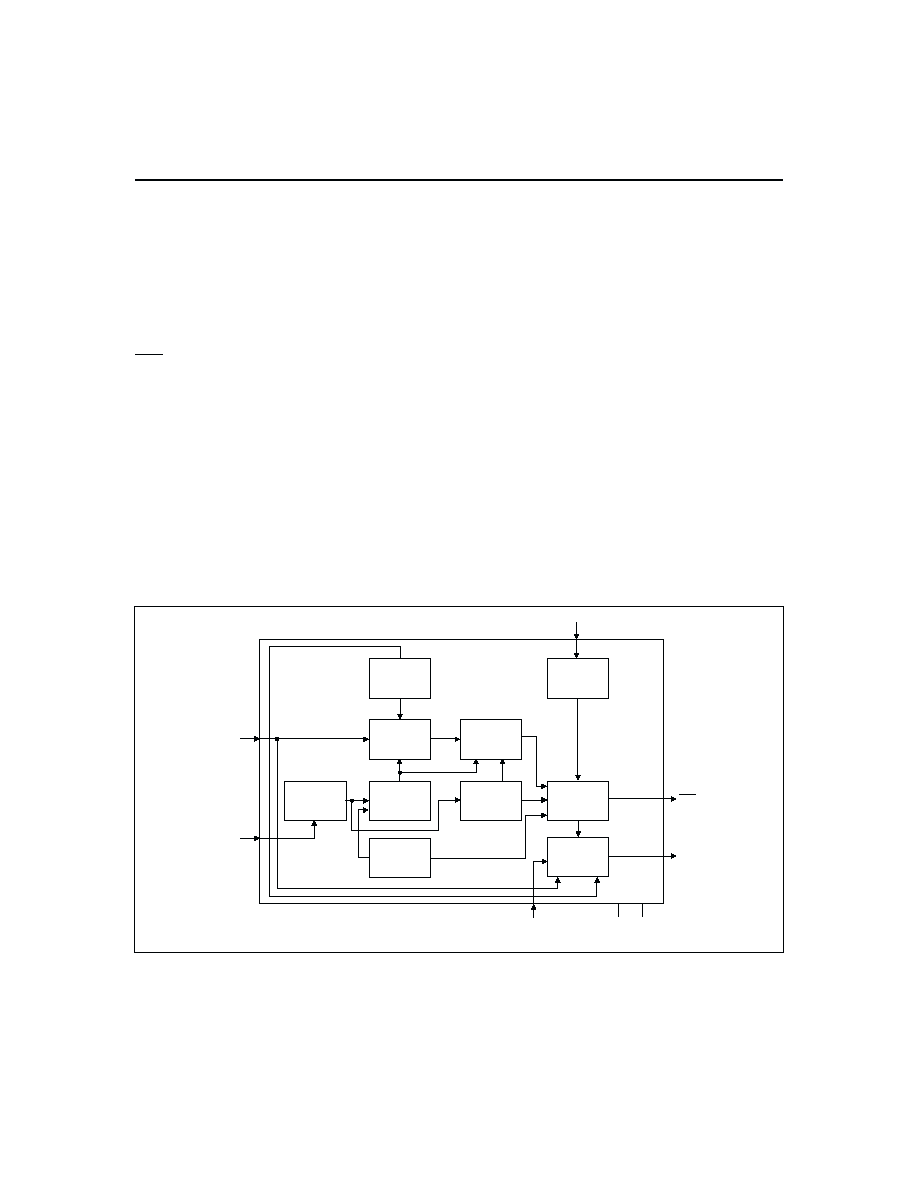
2
Pin Descriptions
SNS
Current-sense input
Enables the bq2000 to sense the battery cur-
rent via the voltage developed on this pin by
an external sense-resistor connected in se-
ries with the battery pack
V
SS
System Ground
LED
Charge-status output
Open-drain output that indicates the charg-
ing status by turning on, turning off, or
flashing an external LED
BAT
Battery-voltage input
Battery-voltage sense input. A simple resistive
divider, across the battery terminals, generates
this input.
TS
Temperature-sense input
Input for an external battery-temperature
monitoring circuit. An external resistive di-
vider network with a negative tempera-
ture-coefficient thermistor sets the lower
and upper temperature thresholds.
RC
Timer-program input
RC input used to program the maximum
charge-time, hold-off period, and trickle
rate during the charge cycle, and to disable
or enable top-off charge
V
CC
Supply-voltage input
MOD
Modulation-control output
Push-pull output that controls the charging
current to the battery. MOD switches high
to enable charging current to flow and low to
inhibit charging- current flow.
Functional Description
The bq2000 is a versatile, multi-chemistry battery-
charge control device. See Figure 1 for a functional block
diagram and Figure 2 for a state diagram.
bq2000
bq2000BD.eps
Voltage
Reference
Internal
OSC
Clock
Phase
Generator
ADC
OSC
SNS
TS
MOD
RC
BAT
LED
V
CC
V
SS
Timer
PVD
ALU
Voltage
Comparator
Voltage
Comparator
Charge
Control
Figure 1. Functional Block Diagram
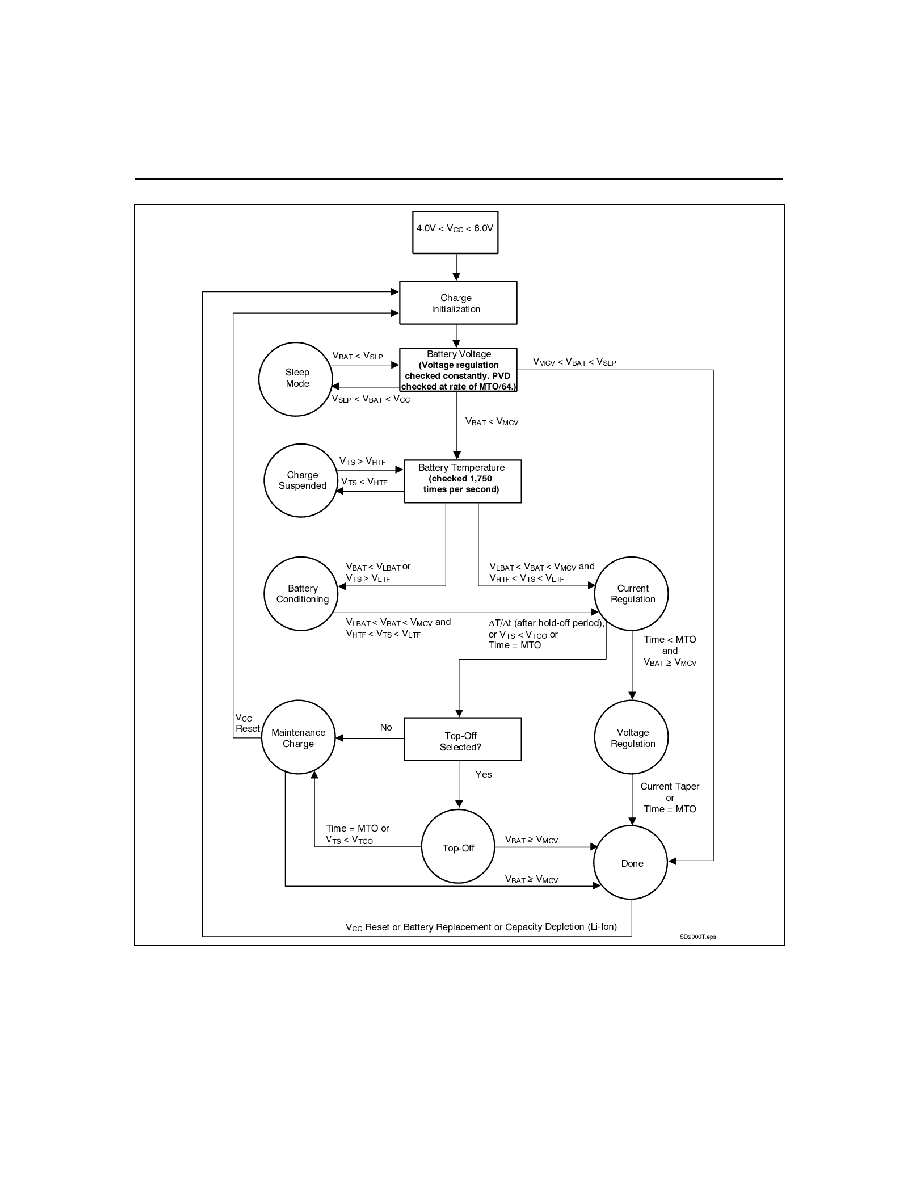
3
bq2000
Figure 2. State Diagram
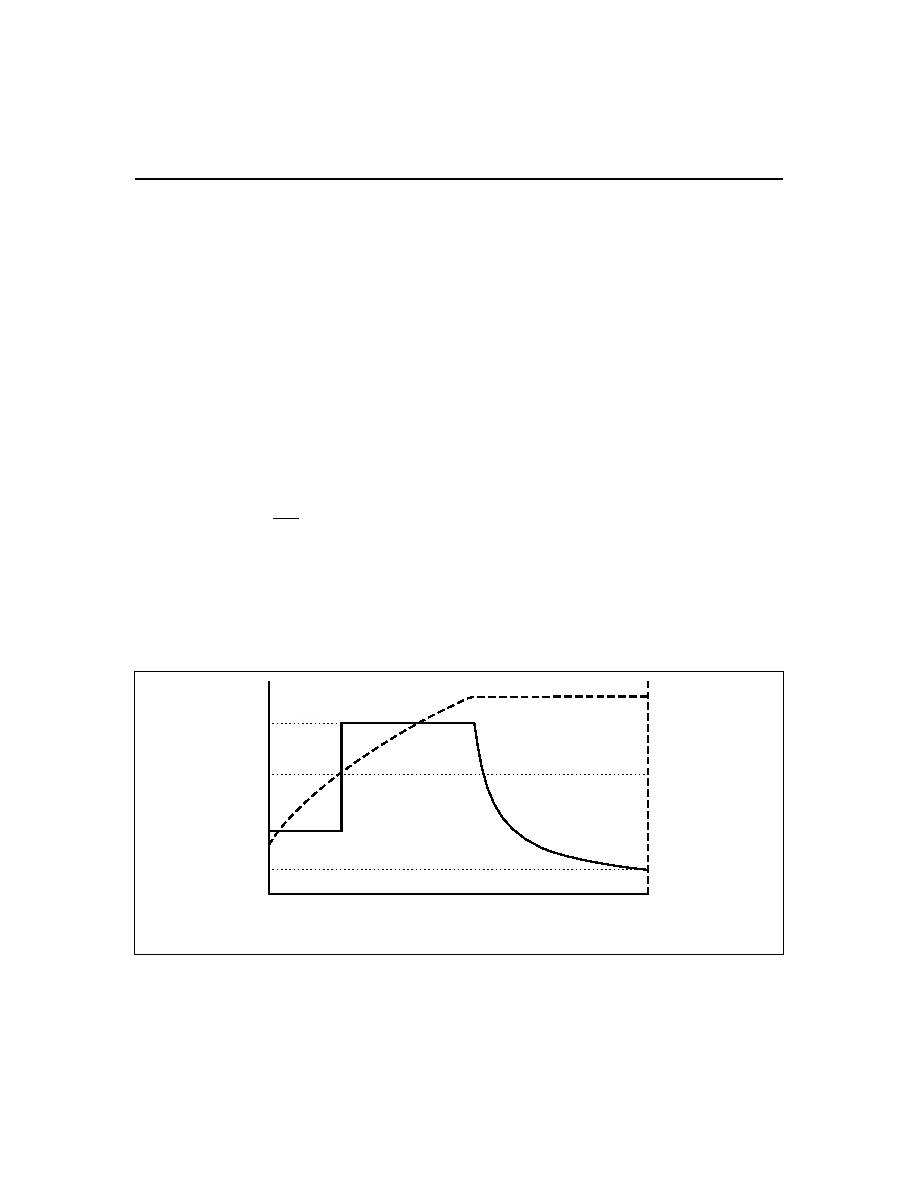
Initiation and Charge Qualification
The bq2000 initiates a charge cycle when it detects
n
Application of power to V
CC
n
Battery replacement
n
Exit from sleep mode
n
Capacity depletion (Li-Ion only)
Immediately following initiation, the IC enters a
charge-qualification mode. The bq2000 charge qualifica-
tion is based on battery voltage and temperature. If
voltage on pin BAT is less than the internal threshold,
V
LBAT
, the bq2000 enters the charge-pending state. This
condition indicates the possiblility of a defective or
shorted battery pack. In an attempt to revive a fully
depleted pack, the bq2000 enables the MOD pin to
trickle-charge at a rate of once every 1.0s. As explained
in the section "Top-Off and Pulse-Trickle Charge," the
trickle pulse-width is user-selectable and is set by the
value of the resistance connected to pin RC.
During this period, the LED pin blinks at a 1Hz rate,
indicating the pending status of the charger.
Similarly, the bq2000 suspends fast charge if the battery
temperature is outside the V
LTF
to V
HTF
range. (See Table
4.) For safety reasons, however, it disables the pulse
trickle, in the case of a battery over-temperature condition
(i.e., V
TS
< V
HTF
). Fast charge begins when the battery
temperature and voltage are valid.
Battery Chemistry
The bq2000 detects the battery chemistry by monitoring
the battery-voltage profile during the initial stage of the
fast charge. If the voltage on BAT input rises to the in-
ternal V
MCV
reference, the IC assumes a Li-Ion battery.
Otherwise the bq2000 assumes NiCd/NiMH chemistry.
As shown in Figure 6, a resistor voltage-divider between
the battery pack's positive terminal and V
SS
scales the
b a t t e r y v o l t a g e m e a s u r e d a t p i n B AT. I n a
mixed-chemistry design, a common voltage-divider is
used as long as the maximum charge voltage of the
nickel-based pack is below that of the Li-Ion pack. Oth-
erwise, different scaling is required.
Once the chemistry is determined, the bq2000 completes
the fast charge with the appropriate charge algorithm
(Table 1). The user can customize the algorithm by
programming the device using an external resistor and
a capacitor connected to the RC pin, as discussed in
later sections.
NiCd and NiMH Batteries
Following qualification, the bq2000 fast-charges NiCd or
NiMH batteries using a current-limited algorithm. Dur-
ing the fast-charge period, it monitors charge time, tem-
perature, and voltage for adherence to the termination
criteria. This monitoring is further explained in later
sections. Following fast charge, the battery is topped off,
if top-off is selected. The charging cycle ends with a
trickle maintenance-charge that continues as long as
the voltage on pin BAT remains below V
MCV
.
4
bq2000
GR2000CA.eps
I
MAX
I
MIN
Trickle
V
LBAT
V
MCV
Current
Voltage
Qualification
Time
Phase 1
Phase 2
Fast Charge
Voltage
Current
Figure 3. Lithium-Ion Charge Algorithm
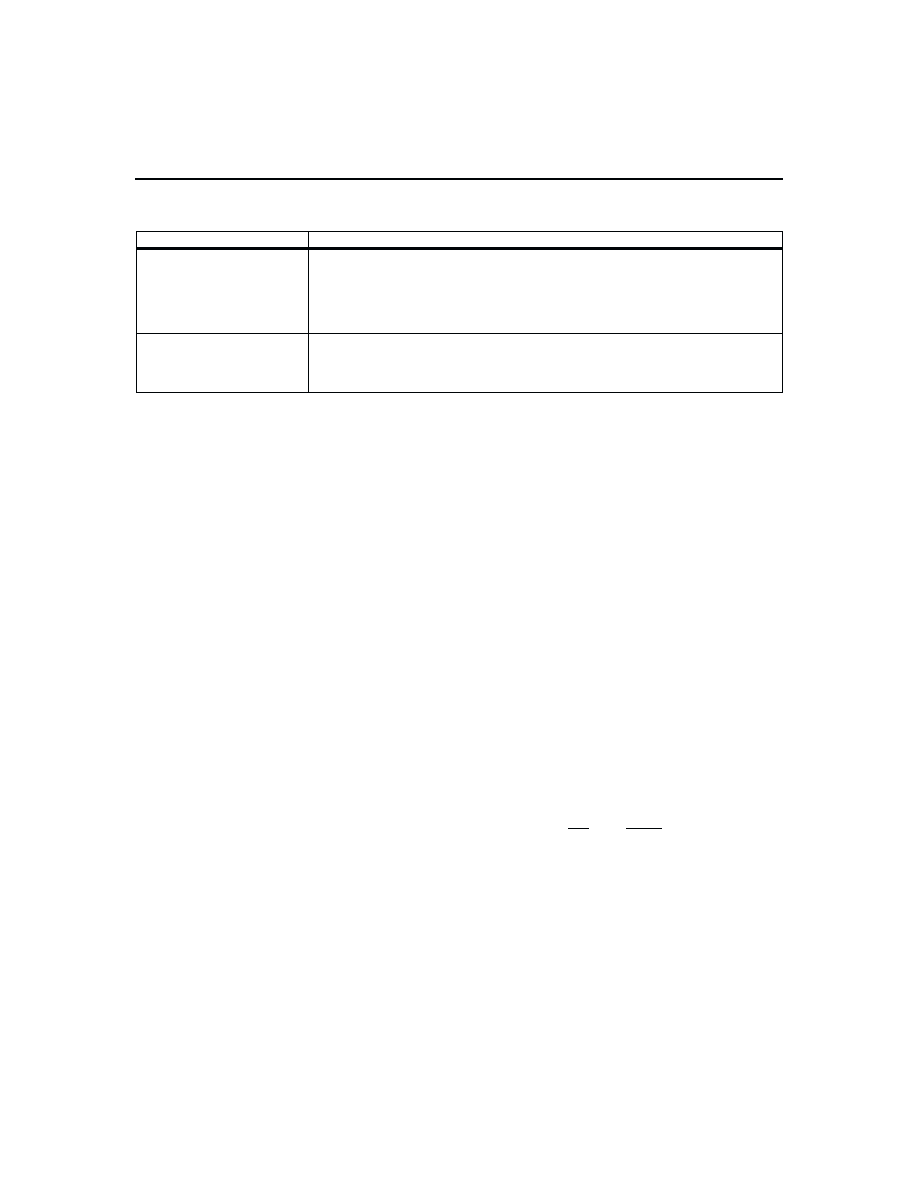
Lithium-Ion Batteries
The bq2000 uses a two-phase fast-charge algorithm for
Li-Ion batteries (Figure 3). In phase one, the bq2000
regulates constant current until V
BAT
rises to V
MCV
. The
bq2000 then moves to phase two, regulates the battery
with constant voltage of V
MCV
, and terminates when the
charging current falls below the I
MIN
threshold. A new
charge cycle is started if the cell voltage falls below the
V
RCH
threshold.
During the current-regulation phase, the bq2000
monitors charge time, battery temperature, and battery
voltage for adherence to the termination criteria. During
the final constant-voltage stage, in addition to the
charge time and temperature, it monitors the charge
current as a termination criterion. There is no
post-charge maintenance mode for Li-Ion batteries.
Charge Termination
Maximum Charge Time (NiCD, NiMH, and
Li-Ion)
The bq2000 sets the maximum charge-time through pin
RC. With the proper selection of external resistor and
capacitor, various time-out values may be achieved. Fig-
ure 4 shows a typical connection.
The following equation shows the relationship between
the R
MTO
and C
MTO
values and the maximum charge
time (MTO) for the bq2000:
MTO = R
MTO
C
MTO
35,988
MTO is measured in minutes, R
MTO
in ohms, and C
MTO
in farads. (Note: R
MTO
and C
MTO
values also determine
other features of the device. See Tables 2 and 3 for de-
tails.)
For Li-Ion cells, the bq2000 resets the MTO when the
battery reaches the constant-voltage phase of the
charge. This feature provides the additional charge time
required for Li-Ion cells.
Maximum Temperature (NiCd, NiMH, Li-Ion)
A negative-coefficient thermistor, referenced to V
SS
and
placed in thermal contact with the battery, may be used
as a temperature-sensing device. Figure 5 shows a typi-
cal temperature-sensing circuit.
During fast charge, the bq2000 compares the battery
temperature to an internal high-temperature cutoff
threshold, V
TCO
. As shown in Table 4, high-temperature
termination occurs when voltage at pin TS is less than
this threshold.
Peak Voltage (NiCd, NiMH)
The bq2000 uses a peak-voltage detection (PVD) scheme
to terminate fast charge for NiCd and NiMH batteries.
The bq2000 continuously samples the voltage on the
BAT pin, representing the battery voltage, and triggers
the peak detection feature if this value falls below the
maximum sampled value by as much as 3.8mV (PVD).
As shown in Figure 6, a resistor voltage-divider between
the battery pack's positive terminal and V
SS
scales the
battery voltage measured at pin BAT.
For Li-Ion battery packs, the resistor values R
B1
and
R
B2
are calculated by the following equation:
R
R
N
V
V
B1
B2
CELL
MCV
=
- 1
where N is the number of cells in series and V
CELL
is the
manufacturer-specified charging voltage. The end-to-
end input impedance of this resistive divider network
should be at least 200k
and no more than 1M.
A NiCd or NiMH battery pack consisting of N series-
cells may benefit by the selection of the R
B1
value to be
N-1 times larger than the R
B2
value.
In a mixed-chemistry design, a common voltage-divider
is used as long as the maximum charge voltage of the
5
Battery Chemistry
Charge Algorithm
NiCd or NiMH
1. Charge qualification
2. Trickle charge, if required
3. Fast charge (constant current)
4. Charge termination (peak voltage, maximum charge time)
5. Top-off (optional)
6. Trickle charge
Li-Ion
1. Charge qualification
2. Trickle charge, if required
3. Two-step fast charge (constant current followed by constant voltage)
4. Charge termination (minimum current, maximum charge time)
Table 1. Charge Algorithm
bq2000




